By Resti Santiago

Jose Rizal, the Filipino Sage, is ruled by Mercury and Jupiter. Artwork by Jimbo Albano.
Japanese artists Ryo Konno and Takahiro Matsui have created a manga about the life of the quintessential Filipino hero, Jose Rizal. It will be released on his natal day—June 19. This is an important development. I think that it is not just millennials who need to re-acquaint themselves with the lives of our heroes but every generation of Filipinos. From the perspective of modern-day myth-makers, I wonder how this manga will inspire the youth, as Rizal has inspired me and my elders.
The first book that I have read from cover-to-cover was the biography of Jose Rizal, written by Gregorio F. Zaide. This was during my growing years in the house of an aunt who was a history teacher. As a kid, I was ushered into Jose Rizal’s world – the 19th-century colonial Philippines. It must have instilled in me the love for the country and also a fascination with the growth of the human spirit as Rizal struggled with his fate and that of the nation. At a crucial stage in our history, reading the story of Rizal is like listening to the wisdom of the “Filipino Sage.”
Laong laan
As an astrologer, what I appreciate most in Rizal, is that he was a firm believer of fate. At crucial turning points in his life, he was always considering what God has ordained for him. The concept of fate comes with the idea that one has a specific role to play in the grander scheme of things.
John Nery, author of the book “Revolutionary Spirit: Jose Rizal in Southeast Asia”, captures the essence of Rizal’s fate with these words:
“But while Rizal’s gift of presentiment was acute (his accounts of some of his premonitory dreams are almost clinical in their precision), and throughout his short life he was shadowed by a sense of destiny (one of his pseudonyms was Laong Laan, a name often translated as “Ever Prepared” but perhaps better rendered as “Preordained”), in fact life never merely unfolded for him. He had to will himself into becoming Rizal.”
At the same time, here is one hero who values free will just as much as his fate. The choices he made in his life and his well-planned choreography facing death at his last breath are clear proofs. As he and his family struggled under the Spanish government, he discovered his mission and made difficult decisions despite knowing the kind of fate that awaits him.
What Was Rizal’s Fate?
The fate of individuals is revealed by the complete astrological chart. The natal chart created based on the date, time and place of birth is a graphic representation of the position of the planets. (To those who wants to have their chart computed, click here.)
In Medieval astrology, which is the kind of astrology that I primarily use, the planets are more important than the signs. So instead of focusing on his sign Gemini, which is quite true in his case, I put more weight on the planet that is prominent in his chart.
As a true-blue Gemini, Rizal was a writer, a cartoonist, a novelist, a teacher. He is multi-talented, a Renaissance man. Gemini is ruled by Mercury, the planet of the mind. In Greek mythology, Mercury or Hermes is considered as the messenger of the Gods. His Sun sign revealed his talents but the totality of his fate goes beyond his Sun sign. The gist of his life’s work comes in the form of three books: Annotations to Sucesos De las Islas Pilipinas, Noli Me Tangere, and El Filibusterismo. What is sad, according to the historian Ambeth Ocampo, is that Rizal wrote a lot for a nation that does not read.
Pisces and Martyrdom
But astrologically speaking, his life mission is not revealed by these talents that he exhibited as a Gemini individual. His fate is revealed by the position of Jupiter, the ruler of his Ascendant sign in Pisces, lodged in the 6th house of his chart. In Medieval astrology, the 6th house is the house of slaves. From the 16th century till the 19th century, the inhabitants of the archipelago lived like slaves in their own land or seas. Jupiter is the planet of justice. His most famous quote “ There are no tyrants, where there are no slaves” encapsulates the meaning of his life.
Pisces is the sign of sacrifice. Historian Floro Quibuyen thinks that this is what made him a venerated hero.
“In Dapitan, Rizal had enough opportunities to escape, but when confronted, in 1896, with the choice between martyrdom and taking up arms, he chose martyrdom. Following his injunction that “pure and spotless must the victim be in order for the sacrifice to be acceptable” Rizal, aged 35, serenely gave his life on 30 Dec 1896, happy at the thought that his country would be redeemed.”
